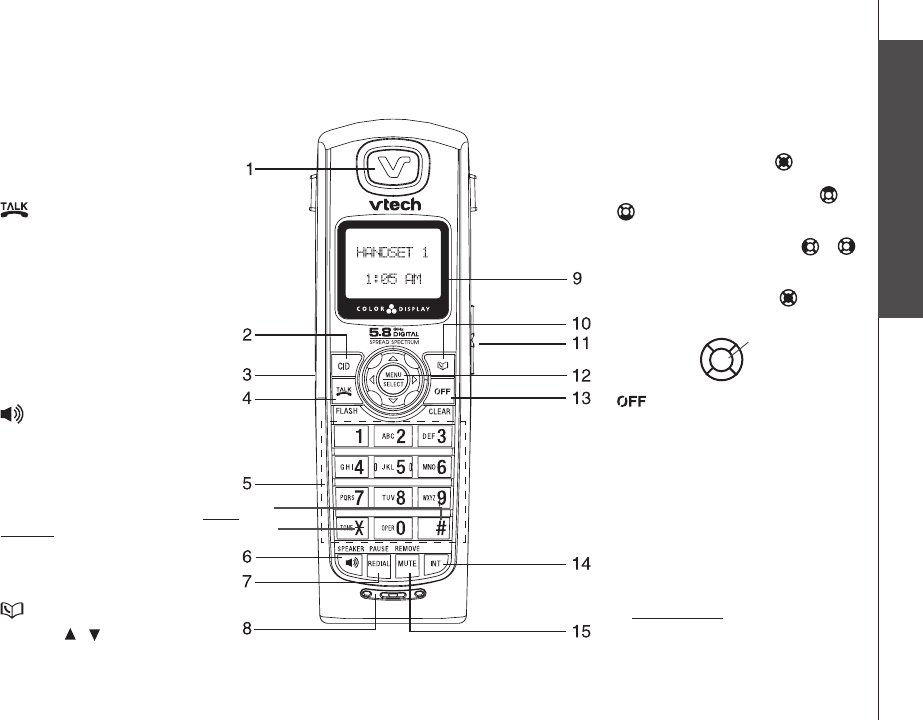Telephone Owner Manual
Table Of Contents
- About caller ID
- About cordless telephones
- Activate the answering system
- Advanced operation
- Answer an incoming call during an intercom call
- Answering intercom and external calls
- Answering system operation
- Answering system setup
- Base lights
- Basic operation
- Battery
- Belt clip
- Belt clip & headset (optional)
- Call log
- Call waiting
- Chart of characters
- Clear voicemail
- Clock setting
- Commands during playback mode:
- Commands in remote standby mode:
- Conference call
- Contrast
- Delete a directory entry
- Delete all messages
- Delete a redial entry
- Delete one or all entries
- Delete your announcement
- Desk/table bracket installation
- Dial a call log entry
- Dial a directory entry
- Dial from redial
- Dial type
- Directory
- Display menu
- Edit a directory entry
- FCC, ACTA and IC regulations
- Find handset
- Handset and base indicators
- Handset display screen messages
- Handset icons
- Handset indicator lights
- Handset layout
- Handset speakerphone
- Headset
- If you subscribe to DSL service
- Important safety instructions
- Installation
- Install handset battery
- Intercom
- Key tone
- Language
- Maintenance
- Make, answer, and end calls with the handset
- Memo playback
- Message capacity
- Message playback
- Message window
- Mute
- New message indication
- Operating range
- Options during playback
- Outgoing announcement
- Parts checklist
- Play your announcement
- Record a memo
- Record and play memos
- Record your announcement
- Redial list
- Remote access
- Review the call log
- Ringer melody
- Ringer mute
- Ringer volume
- Save an entry to the directory
- Search the directory
- Set base ringer
- Set message alert tone
- Set number of rings
- Set remote access code
- Set the clock
- Settings menu
- Store a directory entry
- Technical specifications
- Telephone base installation
- Telephone base layout
- Telephone settings
- Transfer an external call
- Troubleshooting
- Voicemail
- Voicemail service
- Volume
- Wall mounting bracket installation (optional)
- Wallpaper
- Installation
- Telephone settings
- Basic operation
- Advanced operation
- Answering system operation
- Handset display screen messages
- Handset and base indicators
- Battery
- Important safety instructions
- Troubleshooting
- Operating range
- Maintenance
- About cordless telephones
- Limited Warranty
- FCC, ACTA and IC regulations
- Technical specifications

www.vtechphones.com
8
Basic operation
Telephone settings
Telephone settings
Handset layout
1. Earpiece
2.
CID (caller ID)
3. Headset jack (2.5mm)
4.
/FLASH
Press to make or answer a call. During
a call, press to receive an incoming call
if call waiting is activated.
5. Dial pad keys (0-9,
*
, #)
a. Press # repeatedly to display other
dialing options when reviewing the
call log (page 23).
b. Press
*
to switch to tone dialing
temporarily when using the
pulse service.
6. / SPEAKER
Press to activate the handset
speakerphone. Press again to
resume normal handset use.
7. REDIAL/PAUSE
Press to view the redial memory. Press
and hold to insert a dialing pause when
entering numbers.
8. Microphone
9. Handset display
10.
(Directory)
11. Volume (
/ )
CENTER
DOWN
UP
LEFT
RIGHT
12. NavKey
Press the center NavKey to display
menus.
Press the up or down NavKey or
to navigate through menus (see
page 10).
Press the left or right NavKey
or
to navigate through menus (see
page 10).
Press the center NavKey to select
a highlighted menu item.
13. /CLEAR
During a call, press to hang up. While
using the menus, press to return to the
previous menu.
14. INT (intercom)
Press to initiate an intercom
conversation between handsets.
15. MUTE/REMOVE
While on a call, press to mute the
microphone. While reviewing the call
log, press to delete an individual entry,
or press and hold to clear the entire call
log. While entering or editing a name or
number, press to delete a character.
5.a
5.b










